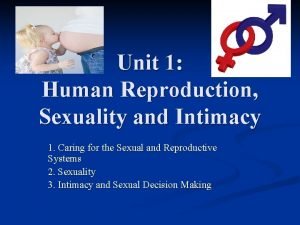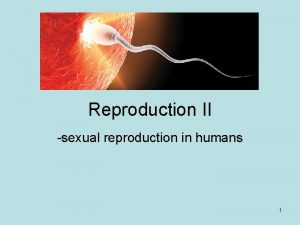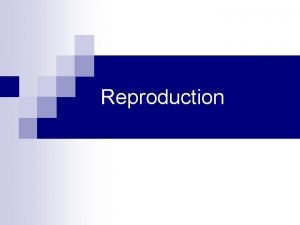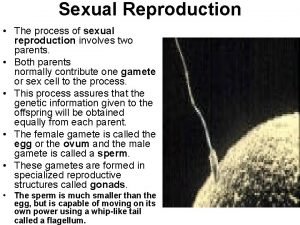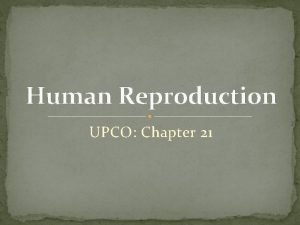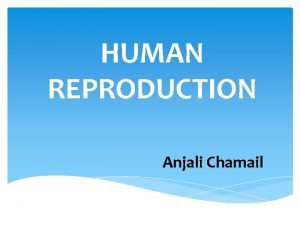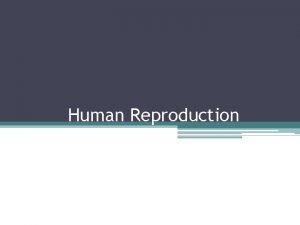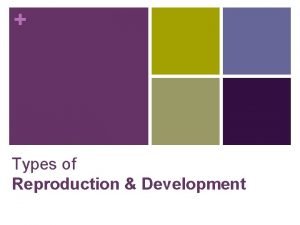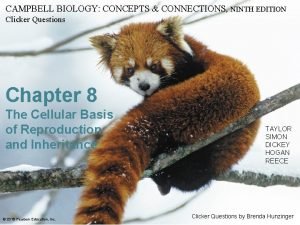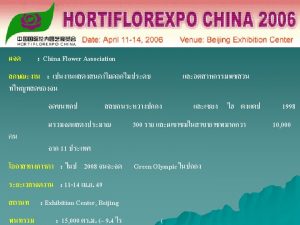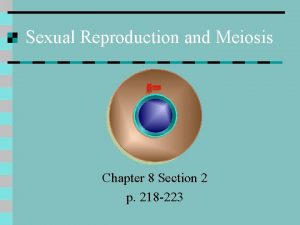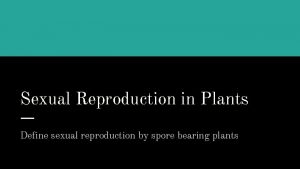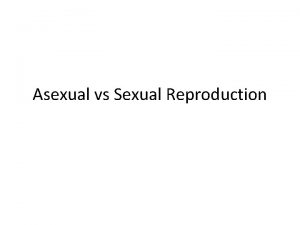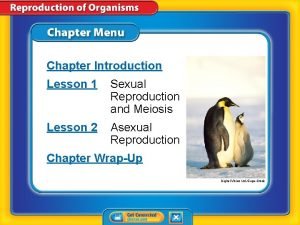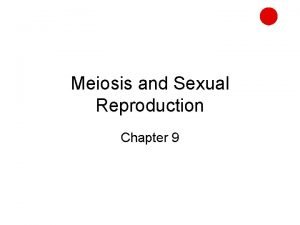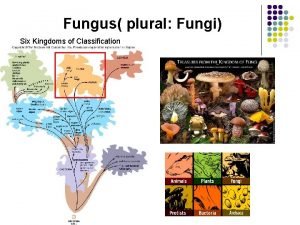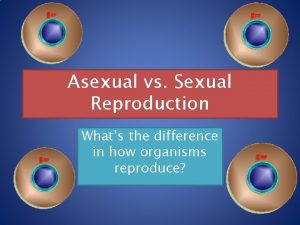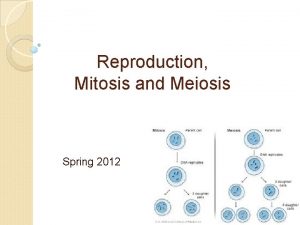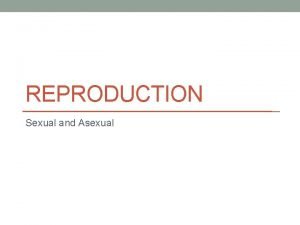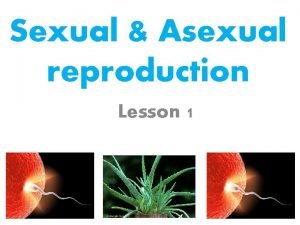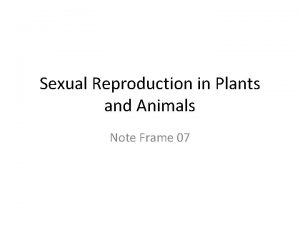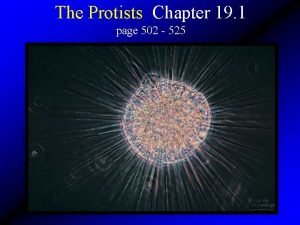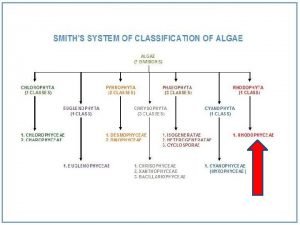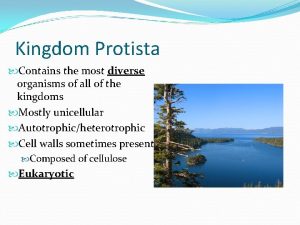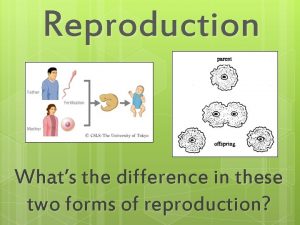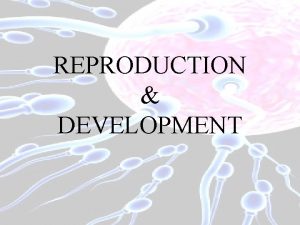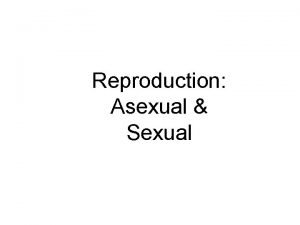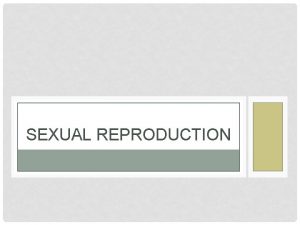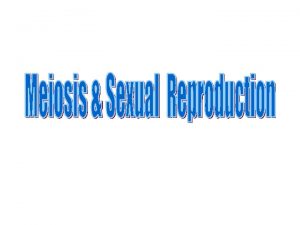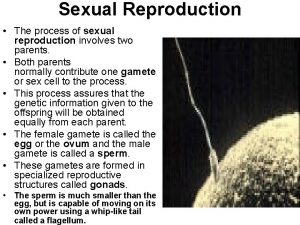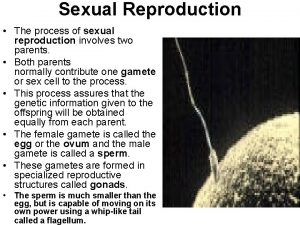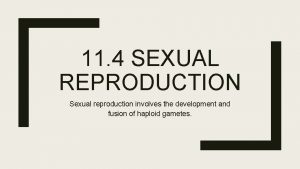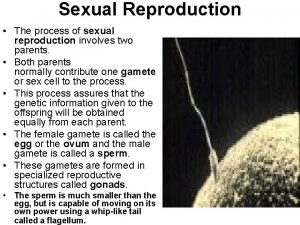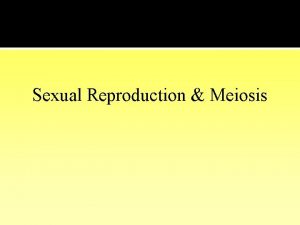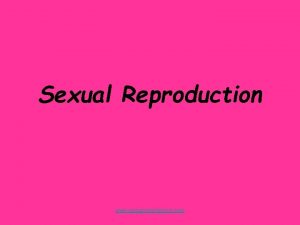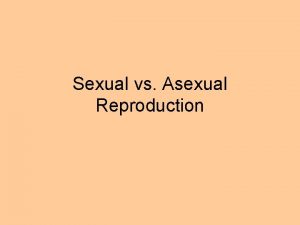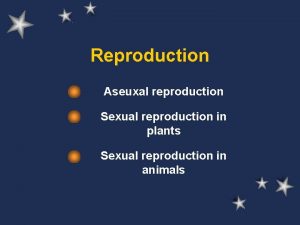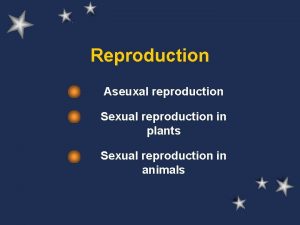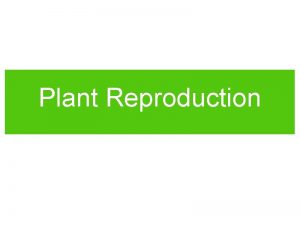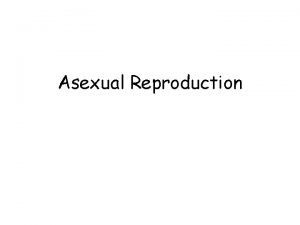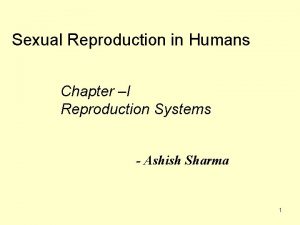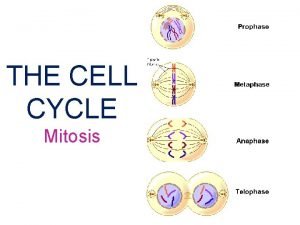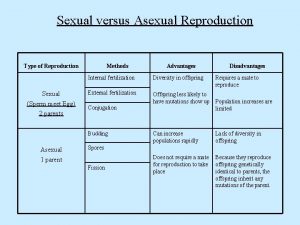Reproduction Humans n Sexual Reproduction Involves parents Increases








































- Slides: 40

Reproduction

Humans n Sexual Reproduction ¨ Involves _____ parents ¨ Increases genetic _____

REVIEW n Gametogenesis is the formation of male and female ________. ¨ Female = ______ ¨ Male = _______ n Occurs by the process of _____ ¨ Reduces chromosome # by ______

Male Reproductive System

Male Reproductive System n Testes ¨ Male gonads ¨ Makes sperm ¨ Contained in scrotum

Male Reproductive System n Vas Deferens ¨ Carries sperm from testes to urethra ¨ When this tube is cut, it is called a vasectomy

Male Reproductive System n Prostate Gland ¨ Secretes a fluid that nourishes sperm and produces semen ¨ Seminal Vesicle makes fluid that contains proteins, enzymes, fructose, mucus, vitamin C and other chemicals.

Male Reproductive System n Penis ¨ Deposits sperm into female reproductive tract

Female Reproductive System

Female Reproductive System n Ovaries ¨ Female gonads ¨ Make eggs (contained in follicles) ¨ Once a woman stops making viable eggs, she is no longer fertile and has gone through menopause n Fun Fact: A girl is born with about 400, 000 immature ova already formed in the ovaries. Only about 400 will mature into eggs in her lifetime.

Female Reproductive System n Fallopian Tubes/Oviduct ¨ Egg is pulled into oviduct by cilia ¨ Site of fertilization

Female Reproductive System n Uterus (womb) ¨ Muscular organ where fertilized egg implants and develops ¨ Cervix is opening to uterus n It dilates during birth

Female Reproductive System n Vagina ¨ Passageway ¨ Birth canal for sperm

Female Reproductive System n Menstrual Cycle ¨ Begins between ages of 10 -14 ¨ A mature egg is released from follicle in ovary every 27 -30 days

Female Reproductive System n Menstrual Cycle (continued) ¨ 4 Stages n 1. Follicle Stage ¨ n 2. Ovulation ¨ n Follicle bursts & egg is released 3. Corpus Luteum Stage ¨ n Egg matures in ovary Hormones cause progesterone to be made, which stimulates thickening of uterine wall 4. Menstruation ¨ Shedding of uterine wall (if fertilized egg is not present)

Fertilization Egg and Sperm meet in oviduct n Zygote is formed n Zygote undergoes mitosis (cleavage) and becomes embryo n

Development 1. Zygote n 7. Blastula n 11. Gastrula n

Gastrula Ectoderm-Skin and Nervous System Mesoderm-Muscles and Heart Endoderm-Digestive Tract and Respiratory System

Development n Twins ¨ Identical Twins: 1 egg and 1 sperm n Fertilized egg splits n ¨ Fraternal n Twins: 2 eggs and 2 sperm

Development Once the zygote travels to the uterus, it implants itself in the uterine wall. n The placenta provides an exchange of materials between the mother and embryo. n ¨ Placenta cord is connected to embryo by umbilical

Development

External Fertilization/Development n In fish, external fertilization and development

Internal Fertilization/External Development n Frogs and Birds

Chicken Egg Anatomy

Developing Chicken Embryo

Asexual Reproduction n Mitosis produces exact copies n Involves 1 “parent”

Types of Asexual Reproduction Binary Fission n Budding n Sporulation n Regeneration n Parthenogenisis n Vegetative Propogation n

Binary Fission

Budding

Sporulation

Regeneration

Parthenogenesis n Certain organisms can reproduce without fertilization ¨ Ex. Bees, worms, snails, etc.

Vegetative Propagation n Plants (aka vegetables) can reproduce new offspring without fertilization ¨ Runners ¨ Bulbs ¨ Tubers ¨ Cuttings ¨ Grafting

Runners n Stems grow out of the existing stems

Bulbs n Bulbous root is underground and stores food and sprouts a new plant

Tubers n Underground root that has stored starch which is used to feed new growths

Cuttings and Grafting n Cuttings and graftings are “artificial” ¨ Cuttings use a part of the root, stem or leaf to re-grow a new plant. ¨ Graftings take a cutting from one plant and attaches it to a different plant

Cuttings

Grafting

Grafting
 Reproduction in humans
Reproduction in humans Sexual reproduction in human
Sexual reproduction in human Blastula
Blastula What is sexual reproduction
What is sexual reproduction Sexual reproduction vs asexual reproduction venn diagram
Sexual reproduction vs asexual reproduction venn diagram Hare lynx
Hare lynx Venn diagram of sexual and asexual reproduction in animals
Venn diagram of sexual and asexual reproduction in animals Reproduction in humans
Reproduction in humans Diagrammatic sectional view of ovary
Diagrammatic sectional view of ovary Reproduction in humans
Reproduction in humans Pedigree miscarriage symbol
Pedigree miscarriage symbol Sexual reproduction
Sexual reproduction Asexual and sexual reproduction venn diagram
Asexual and sexual reproduction venn diagram Solutions for campbell biology concepts & connections 8th
Solutions for campbell biology concepts & connections 8th A sexual reproduction in plants
A sexual reproduction in plants Sexual reproduction
Sexual reproduction Define sexual reproduction
Define sexual reproduction Sexual or asexual reproduction
Sexual or asexual reproduction Difference of sexual and asexual reproduction
Difference of sexual and asexual reproduction Reproduction of organisms
Reproduction of organisms Meiosis
Meiosis Example of asexual reproduction
Example of asexual reproduction Sexual reproduction
Sexual reproduction Plants and animals reproduction venn diagram
Plants and animals reproduction venn diagram Fungi plural form
Fungi plural form Whats sexual reproduction
Whats sexual reproduction Mitosis definition
Mitosis definition Sexual reproduction and genetics section 1 meiosis
Sexual reproduction and genetics section 1 meiosis Asexual or sexual reproduction
Asexual or sexual reproduction Significance of sexual reproduction
Significance of sexual reproduction Chapter 10 section 3 gene linkage and polyploidy
Chapter 10 section 3 gene linkage and polyploidy Mitosis vs meiosis
Mitosis vs meiosis Where does cactus store water
Where does cactus store water Sexual reproduction in paramecia is called _____.
Sexual reproduction in paramecia is called _____. Diagram of rhodophyta
Diagram of rhodophyta Sexual organisms examples
Sexual organisms examples Protists three groups
Protists three groups Which kingdom is most diverse
Which kingdom is most diverse Whats reproduction
Whats reproduction Asexual or sexual reproduction
Asexual or sexual reproduction Asexual or sexual reproduction
Asexual or sexual reproduction
